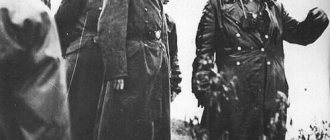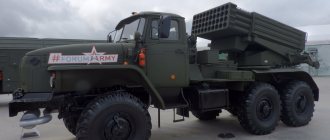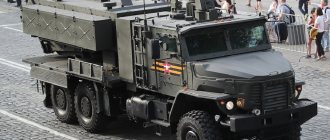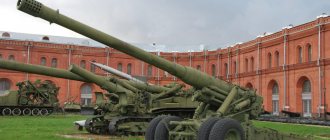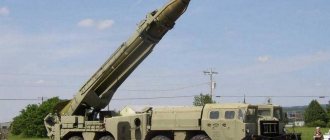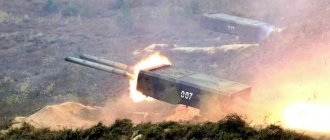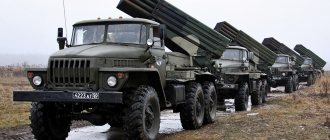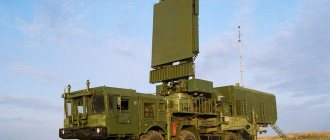Today, however, as always, the security of the state and its residents has the highest priority. Numerous military conflicts and instability around our country make us think about strengthening our security, including nuclear security. Since the Cold War, the USSR, and subsequently its successor, the Russian Federation, have been forced to ensure security by creating an effective system of defense against an unforeseen nuclear attack. But it's not just protection that's needed. The presence of combat-ready nuclear weapons makes it possible to deter the aggressive intentions of potential enemies.
Against the background of such prerequisites, the “Perimeter” system was developed, called the “dead hand” by the Western media, and “the hand from the coffin” in the eastern part of the planet. Let's try to figure it out what kind of weapon this is.
The history of the "Dead Hand"
The next round of the Cold War between the USSR and Western countries prompted domestic designers in 1975 to develop an autonomous system called “Perimeter”. Its predecessor, “Monolith,” had a number of disadvantages, the most significant of which was that the order to activate was given by a living person.
The peculiarity of the system is as follows: when an apocalyptic scenario occurs, when everyone dies and there is not a single person left who can give the order to launch a retaliatory strike, “Perimeter” will work automatically. At the same time, options for involuntary system startup are completely excluded by conducting a system analysis of all factors that influence the activation of the system.
“Perimeter” takes into account the internal political situation and the situation in the international arena, the presence or absence of radio communications between various units of the Strategic Missile Forces and other factors. It’s not for nothing that the world calls it a “doomsday machine” or a weapon that guarantees a nuclear retaliatory strike. Moreover, such a system exists only as part of the nuclear shield of the Russian Federation.
American military designers tried to create something similar to the “dead arm”, but their attempts were unsuccessful and they abandoned further work in this direction.
The Yuzhnoye Design Bureau, which specialized in creating ICBMs (intercontinental ballistic missiles) with nuclear warheads, was tasked with developing an autonomous system. The MR-R100UTTH rocket was taken as the basis. Currently, modernized ICBMs are used as command devices, which do not carry a combat charge, but fly over their territory and transmit radio signals to all nuclear missiles equipped with appropriate receivers.
The submarine fleet, strategic aviation aircraft, surface naval forces, and control centers of the Strategic Missile Forces were connected to the Perimeter. At the end of 1975, a preliminary design of the main rocket was developed.
Developers from the Leningrad Polytechnic Design Bureau. Kalinin created a unique radio-technical system, the functionality of which was ensured through continuous orientation on the ground and in the air.
The Orenburg NPO Strela designed and manufactured a warhead with a transmitter equipped with a calming system that stabilizes and orients the movement of the rocket through the use of compressed gas. This reduced the creation time and reduced the cost of producing the rocket.
The rocket's autonomous system, equipped with a quantum optical gyrometer and autogyrocompass, calculates the correct direction of movement in the event of an unexpected nuclear impact in the area of the launcher. Since 1979, tests have been carried out on a complex of all components of the Perimeter.
As a result, the "Dead Hand" was put into combat post in 1985. During seven tests, the most complex algorithms for the joint operation of all systems, compliance by the missiles with designated trajectories and flight ranges, and confirmation of the accuracy of technical indicators were successfully tested.
What does Perimeter consist of?
We do not know too much about the elements of the Perimeter system, and it is possible that some of the available information is “misinformation”, specially disseminated to hide the truth. This complex includes:
- command post (or posts);
- rockets for transmitting orders;
- receiving devices;
- autonomous control and computing complex.
The command posts of the Perimeter system are probably similar to conventional command posts of the Strategic Missile Forces. They are equipped with communications systems and equipment necessary to launch command missiles. The “Grotto” object, which is located in the Kosvinsky Kamen mountain range in the Urals, is most often referred to as such a control point. It is unknown how many such points exist, and how integrated they are with the command missile launchers.
The Command Missile is the most famous component of the Perimeter. It was initially developed on the basis of the UR-100 ICBM, but there is information that there were also command missiles based on the Pioneer IRBM, and in the late 80s the Topol was “adapted” to perform this task. The command rocket has a powerful radio transmitter through which the order “Launch!” is given. all ballistic missiles that survived the first enemy strike.
Receiving devices. They ensure that orders are received from the command missile; accordingly, all launch silos and command posts of the Strategic Missile Forces, missile-carrying submarines and strategic aircraft must be equipped with them. However, nothing is known about their structure and operating principles.
The Autonomous Command System is, without a doubt, the most mysterious and interesting part of the Perimeter. There is no official or at least any reliable data about it. Many people don’t believe in its existence at all. The main debate is over whether there is a so-called Doomsday Machine - a kind of supercomputer based on artificial intelligence - which is capable of making a decision on the use of nuclear weapons itself, without human intervention.
Components of the "Perimeter"
The “perimeter” consists of many sensors that constantly monitor a number of factors:
- monitoring and analysis of conversations on radio broadcasts on specialized radio waves;
- telemetric indicators from the locations of Strategic Missile Forces facilities;
- presence and indicators of radiation in areas of deployment;
- electromagnetic and ionizing radiation in given coordinates;
- confirmation of the presence of living people at the checkpoint;
- analysis of the internal political situation and military-political situation in the world.
Basic elements of the “hand from the coffin”
| № | Name | Compound |
| 1 | Command posts | Equipped with instrumentation and radio communications, missile bunkers |
| 2 | Command missiles | 15A11 silo-based missile with command system |
| 3 | Receivers | Radio devices that receive and transmit commands and start codes for all components of the system |
| 4 | Autonomous control and command system | Analytical center for collecting and transmitting information influencing the decision to launch |
It should be noted that most of the components and components of the system are classified today, so the available information should be treated with some skepticism.
Two scenarios for the operation of “Perimeter” are considered:
- When the theoretical prerequisites for a nuclear attack by the enemy arise as a result of an international conflict, the commander-in-chief, who is also the president of the country, switches the complex to combat standby mode. If after a specific period of time the order is not withdrawn, then the “dead hand” will independently give the command to start the components - missiles with a lethal warhead.
- Independent activation of the components of the “Perimeter” as a result of a preliminary analysis of the data it collects. But, according to available information, the launch of the command rocket is still carried out manually.
One of the creators of Perimeter, V. Yarynich, noted in one of his interviews that the system independently determines whether a nuclear strike has been carried out on Russia. In the absence of communication with the General Staff, she delegates the authority to launch nuclear weapons to the nearest employee of the protected bunker.
“Made with us” and on Yandex.Zen
Perimeter system
The American magazine Wired fearfully writes: Russia has the only weapon in the world that guarantees a retaliatory nuclear strike against the enemy, even in the terrible event that we no longer have anyone to decide on this strike. The unique system counterattacks automatically – and brutally.
The “Perimeter” system (Strategic Missile Forces Airborne Forces Index - 15E601, nicknamed “Dead Hand” in the West, and “Hand from the Coffin” in the East) is a control system for strategic missile forces - Strategic Missile Forces. In the documents it received the name “Perimeter”. The system involved the creation of such technical means and software that would make it possible, in any conditions, even the most unfavorable, to convey the order to launch missiles directly to the launch teams. According to the creators of Perimeter, the system could prepare and launch missiles even if everyone died and there was no one to give the order. This component began to be unofficially called “Dead Hand or Hand from the Coffin.”
How the system works: The logic of the Dead Hand’s actions involved the regular collection and processing of a gigantic amount of information. A variety of information was received from all kinds of sensors. For example, about the state of communication lines with a higher command post: there is a connection - there is no connection. About the radiation situation in the surrounding area: normal level of radiation - increased level of radiation. About the presence of people at the starting position: there are people - there are no people. About registered nuclear explosions and so on and so forth. The “Dead Hand” had the ability to analyze changes in the military and political situation in the world - the system assessed commands received over a certain period of time, and on this basis could conclude that something was wrong in the world. When the system believed that its time had come, it became active and launched a command to prepare for the launch of the rockets. Moreover, the “Dead Hand” could not begin active operations in peacetime. Even if there was no communication, even if the entire combat crew left the starting position, there were still a lot of other parameters that would block the operation of the system.
After an order received from the highest echelons of the Strategic Missile Forces control to a special command post, the 15P011 command missile with a special 15B99 warhead is launched, which in flight transmits launch commands to all launchers and command posts of the Strategic Missile Forces that have the appropriate receivers.
System concept:
The system is designed to guarantee the launch of silo-based ICBMs and SLBMs in the event that, as a result of a crushing nuclear strike by the enemy on the territory of the USSR, all command units of the Strategic Missile Forces capable of ordering a retaliatory strike are destroyed. The system is the only doomsday machine (weapon of guaranteed retribution) in existence in the world, the existence of which has been officially confirmed. The system is still classified and may still be on combat duty to this day, so any information about it cannot be confirmed as unequivocally reliable, or refuted, and should be viewed with a due degree of skepticism.
At its core, the Perimeter system is an alternative command system for all branches of the military armed with nuclear warheads. It was created as a backup system in case the key nodes of the Kazbek command system and the communications lines of the Strategic Missile Forces were destroyed by the first strike, in accordance with the concept of Limited Nuclear War developed in the United States. To ensure the guaranteed fulfillment of its role, the system was initially designed as fully automatic and, in the event of a massive attack, is capable of making a decision on a retaliatory strike independently, without the participation (or with minimal participation) of a person. The existence of such a system in the West is called immoral, but it is essentially the only deterrent that provides real guarantees that a potential enemy will renounce the concept of a preventive crushing strike.
History of creation :
The development of a special command missile system, called “Perimeter”, was assigned to the Yuzhnoye Design Bureau by USSR Government Decree N695-227 of August 30, 1974. It was initially planned to use the MR-UR100 (15A15) missile as the base missile; later they settled on the MR-UR100 UTTH (15A16) missile. The missile, modified in terms of its control system, received the index 15A11.
Command missile 15A11 of the Perimeter system
In December 1975 The preliminary design of the command rocket was completed. The rocket was equipped with a special warhead, indexed 15B99, which included an original radio engineering system developed by OKB LPI. To ensure the conditions for its functioning, the warhead had to have a constant orientation in space during flight. A special system for its calming, orientation and stabilization was developed using cold compressed gas (taking into account the experience of developing the propulsion system for the Mayak SNG), which significantly reduced the cost and time of its creation and testing. The production of SGC 15B99 was organized at NPO Strela in Orenburg.
After ground testing of new technical solutions in 1979. LCT of the command rocket began. At NIIP-5, sites 176 and 181, two experimental mine launchers were put into operation. In addition, a special command post was created at site 71, equipped with newly developed unique combat control equipment to provide remote control and launch of a command missile according to orders coming from the highest echelons of the Strategic Missile Forces control. At a special technical position in the assembly building, a shielded anechoic chamber was built, equipped with equipment for autonomous testing of the radio transmitter.
Flight tests of the 15A11 missile (see layout diagram) were carried out under the leadership of the State Commission headed by Lieutenant General V.V. Korobushin, First Deputy Chief of the Main Staff of the Strategic Missile Forces.
The first launch of the 15A11 command rocket with an equivalent transmitter was successfully carried out on December 26, 1979. The developed complex algorithms for interfacing all systems involved in the launch were tested, the ability of the missile to ensure the given flight path of the MC 15B99 (trajectory apex at an altitude of about 4000 km, range 4500 km), the operation of all service systems of the MC in normal mode, and the correctness of the adopted technical solutions was confirmed.
10 missiles were allocated for flight testing. In connection with the successful launches and the accomplishment of the assigned tasks, the State Commission considered it possible to be satisfied with seven launches.
During the testing of the Perimeter system, real launches of 15A14, 15A16, 15A35 missiles were carried out from combat facilities according to orders transmitted by the SGCh 15B99 in flight. Previously, additional antennas were mounted on the launchers of these missiles and new receiving devices were installed. All launchers and command posts of the Strategic Missile Forces subsequently underwent these modifications.
The 15P716 launcher is a silo-type, automated, highly protected, “OS” type.
Along with flight tests, a ground test of the functionality of the entire complex was carried out under the influence of the damaging factors of a nuclear explosion at the test site of the Kharkov Institute of Physics and Technology, in the testing laboratories of VNIIEF (Arzamas), and at the Novaya Zemlya nuclear test site. The tests carried out confirmed the operability of the control system and SGCh equipment at levels of exposure to a nuclear explosion exceeding those specified in the TTT MO.
Even during the flight tests, a government decree set the task of expanding the functions solved by the command missile complex, with the delivery of combat orders not only to Strategic Missile Forces facilities, but also to strategic missile submarines, long-range and naval missile-carrying aircraft at airfields and in the air, points control of the Strategic Missile Forces, Air Force and Navy.
The flight tests of the command rocket were completed in March 1982. In January 1985 the complex was put on combat duty. For more than 10 years, the command missile complex has successfully fulfilled its important role in the defense capability of the state.
System components:
System command posts:
Apparently, they are structures similar to standard missile bunkers of the Strategic Missile Forces. They contain the control equipment and communication systems necessary to ensure the operation of the system. Presumably integrated with command missile launchers, however, most likely they are spaced at a fairly large distance to ensure better system survivability.
Command missiles:
Command missile 15A11 of the Perimeter system. The only widely known component of the complex. They are part of the 15P011 command missile complex and have the index 15A11, developed by the Yuzhnoye Design Bureau on the basis of the 15A16 missiles (MR UR-100U). Equipped with a special warhead 15B99, containing a radio-technical command system developed by OKB LPI, designed to ensure the delivery of combat orders from the central command post to all command posts and launchers under conditions of exposure to nuclear explosions and active electronic countermeasures, when the warhead is flying on a passive part of the trajectory. The technical operation of the missiles is identical to the operation of the base 15A16 missile. The 15P716 launcher is a silo-type, automated, highly protected OS type, most likely a modernized OS-84 launcher. The possibility of basing missiles in other types of launch silos cannot be ruled out.
The development of a command missile began under the TTT of the Ministry of Defense in 1974. Flight design tests were carried out at NIIP-5 (Baikonur) from 1979 to 1986. A total of 7 launches were carried out (6 successful, 1 partially successful). The mass of the warhead 15B99 is 1412 kg.
Receiving devices:
They ensure that the components of the nuclear triad receive orders and codes from command missiles in flight. They are equipped with all launchers of the Strategic Missile Forces, all SSBNs and strategic bombers. Presumably, the receiving devices are hardware connected to the control and launch equipment, ensuring autonomous execution of the launch order.
Autonomous control and command system:
The mythical component of the system is a key element of the Doomsday Machine, the existence of which there is no reliable information. Some proponents of the existence of such a system believe that it is a complex expert system, equipped with many communication systems and sensors that monitor the combat situation. This system supposedly monitors the presence and intensity of conversations on air at military frequencies, the receipt of telemetry signals from Strategic Missile Forces posts, the level of radiation on the surface and in the surrounding area, the regular occurrence of point sources of powerful ionizing and electromagnetic radiation at key coordinates, coinciding with sources of short-term seismic disturbances in the earth's crust (which corresponds to the picture of multiple ground-based nuclear strikes), and, possibly, the presence of living people at the command post. Based on the correlation of these factors, the system probably makes the final decision on the need for a retaliatory strike.
Another proposed option for the system’s operation is that upon receiving information about the first signs of a missile attack, the Supreme Commander-in-Chief switches the system to combat mode. After this, if within a certain time the system command post does not receive a signal to stop the combat algorithm, then command missiles are launched.
System location:
The automated system "Perimeter" is installed in the area of Mount Kosvinsky Kamen (Ural). According to Blair, “American strategists consider it to be the crown jewel of the Russian nuclear combat command system, since it can communicate through the granite mass with Russian long-range strategic aviation using a VLF radio signal (3.0 - 30.0 kHz) capable of propagation even in a nuclear war. This bunker is a critical link in the doomsday machine's communications network, designed to provide semi-automatic retaliation in response to a decapitation strike."
Operation and system status:
After being put on combat duty, the complex worked and was periodically used during command post exercises. The 15P011 command missile system with the 15A11 missile (based on the UR-100 MP) was on combat duty until June 1995, when, as part of the START-1 agreement, the complex was removed from combat duty. According to other sources, this happened on September 1, 1995, when the 510th missile regiment, armed with command missiles, was taken off duty in the 7th missile division (Vypolzovo village) and disbanded. This event coincided with the completion of the withdrawal of MR UR-100 missiles from the Strategic Missile Forces and the process of rearmament of the 7th RD with the Topol mobile ground missile system, which began in December 1994.
In December 1990, in the 8th Missile Division (urban town of Yurya), a regiment (commander - Colonel S.I. Arzamastsev) with a modernized command missile system, called “Perimeter-RC”, which included a command missile, took up combat duty , created on the basis of the RT-2PM Topol ICBM.
There is also evidence that previously the Perimeter system, along with 15A11 missiles, included command missiles based on the Pioneer MRBM. Such a mobile complex with “pioneer” command missiles was called “Gorn”. The complex index is 15P656, the missiles are 15Zh56. It is known about at least one unit of the Strategic Missile Forces, which was armed with the Horn complex - the 249th Missile Regiment, stationed in the city of Polotsk, Vitebsk Region, 32nd Missile Division (Postavy), from March-April From 1986 to 1988 it was on combat duty with a mobile complex of command missiles.
Organizations involved in the production of components and technical maintenance of the complex are experiencing difficulties with financing. Staff turnover is high, resulting in a decline in staff qualifications. Despite this, the Russian leadership has repeatedly assured foreign states that there is no risk of accidental or unauthorized missile launches.
In the Western press the name “Dead hand” was assigned to the system.
In Japan, military experts dubbed this system as the "Hand from the Coffin".
According to Wired magazine in 2009, the Perimeter system is operational and ready to strike back.
In December 2011, the commander of the Strategic Missile Forces, Lieutenant General Sergei Karakaev, stated that the Perimeter system exists and is on combat duty.
Operators:
Russia (The system is currently active).
P/N. Excerpt from an interview given by the Commander of the Strategic Missile Forces, Lieutenant General Sergei V. Iktorovich Karakaev: https://www.kp.ru/daily/25805/2785953/
WHY DOES RUSSIA HAVE A DEAD HAND?
KP: — At one time, there were publications in our and foreign press about the “Perimeter” system, which existed in the USSR. And in 2009, the American magazine Wyret told its readers that this system is functioning and is still alive. This is the rocket that, if everything is lost, takes off and gives the command to all the other rockets. And they automatically take off and hit the desired targets. This system is called “dead hand” in the West.
Sergey Karakaev: - It’s not in vain that you eat your bread! Yes, the Perimeter system exists today. She's on combat duty. And when the need arises for a retaliatory strike, when it is not possible to reach some part of the launchers with a signal, this command can come from these missiles from the “Perimeter”...
KP: — There was a very interesting remark from Putin at a meeting with the Valdai Club. There someone tells him: “You can destroy the United States in about half an hour.” And Putin thought and thought and replied: “Actually, faster”...
Sergey Karakaev: — I’ll answer briefly: Vladimir Vladimirovich is right. But I believe that today neither Russia nor the United States are going to destroy each other.
Related links:
https://www.cosmoworld.ru/...ndex.shtml?zhelez_22.html
https://military-today.ru/…/15-sistema-perimetr.html
https://masterok.livejournal.com/501495.html
Basing
Information about the actual location of the Perimeter is, of course, classified. According to unconfirmed information, the main checkpoint is located in the Urals, presumably near Kosvinsky Kamen. The bunker is built from duanite and pyroxenite, so radio-VLF communication is easily carried out in it, maintaining functionality at high levels of radiation.
Initially, closed, classified horizontal platinum mines were used to build the bunker. The rocks from which fire-resistant building materials were made block scanning radio emissions and prevent leakage of information about the exact location of the command post. The bunker was equipped with additional power lines for uninterrupted operation. Infrastructure projects such as bridges and new roads were built.
Combat use
Kak o is still a very secret object, so there is very little reliable information about its location and possible uses. According to unofficial data, the complex stood on the lines of defense of our Motherland until the summer of 1995, and was recalled from its combat post in accordance with the terms of the SVR-1 agreement. According to other sources of information, the “Dead Hand” still serves in combat formation, it is only further modernized.
The system became known as “Perimeter - RC”, the 15A11 missile was replaced by the RT-2PM Topol intercontinental ballistic missile, which further expanded the possibilities of its use.
Commander of the Russian Strategic Missile Forces Karakaev S.V. said that Perimeter operates in standby mode, but collects incoming information and can be ready for use at any moment.
In 2022, the newest ballistic missile “Skif” became operational in the Strategic Missile Forces of the Russian Federation. Tests have confirmed that this “new product” of the military industry reaches speeds at launch of up to 4000 m per minute and quickly goes into the stratosphere, making it unattainable for the enemy’s missile defense system.
This rocket can remain at rest at the bottom of the sea or ocean for an unlimited time, and if it receives a command to launch, it is activated and takes off immediately. At the same time, it is not at all necessary from on board a submarine.
Basically, information about “Skif” is also classified, but according to some sources it includes about twenty warheads with a nuclear charge.
Skif-type missiles fly at speeds approaching hypersonic. They cannot be detected by modern missile defense systems. Experts say that in the near future “Skif” will be included in the “Perimeter” system.
It is difficult to say when the “top secret” classification will be removed from the entire complex, perhaps when missiles of this type are no longer needed or useless.
Consequences of the system triggering
If “Dead Hand” works, it won’t lead to anything happy. All nuclear weapons at Russia's disposal will be used to strike the most important targets. Hundreds of missiles are launched simultaneously - not only from silos and mobile launchers of the Strategic Missile Forces, but also from submarines. 30-40 minutes after this massive strike, the United States of America will cease to exist, and along with them, their European NATO allies.
Perhaps humanity will be able to survive after this global catastrophe, but it will be thrown back thousands of years. Huge cities will turn into cemeteries, entire countries will become uninhabitable. Those who survive the war are guaranteed famine and epidemics.
Of course, from time to time bravura articles appear in the West, the authors of which, using a variety of arguments, try to prove that Russian strategic weapons have long been faulty, and “Perimeter”, aka Dead Hand, is just a myth of the Cold War, a name without practical content. But it’s unlikely that anyone will want to check the reliability of reasoning of this kind. As a matter of fact, Yarynich’s move to the USA was to a certain extent beneficial for the security of Russia - after all, it is not enough just to build a “Doomsday Machine”, it is also necessary for the enemies to know about its presence.
The destruction of modern civilization may be a spectacular spectacle, but few will survive it.
According to representatives of the Russian military command, the 15E601 system is still functioning, remaining guarding the borders of the state. It can be assumed that it has been modernized several times, but all information about this remains classified.
